10 Herbal Teas For High Cholesterol
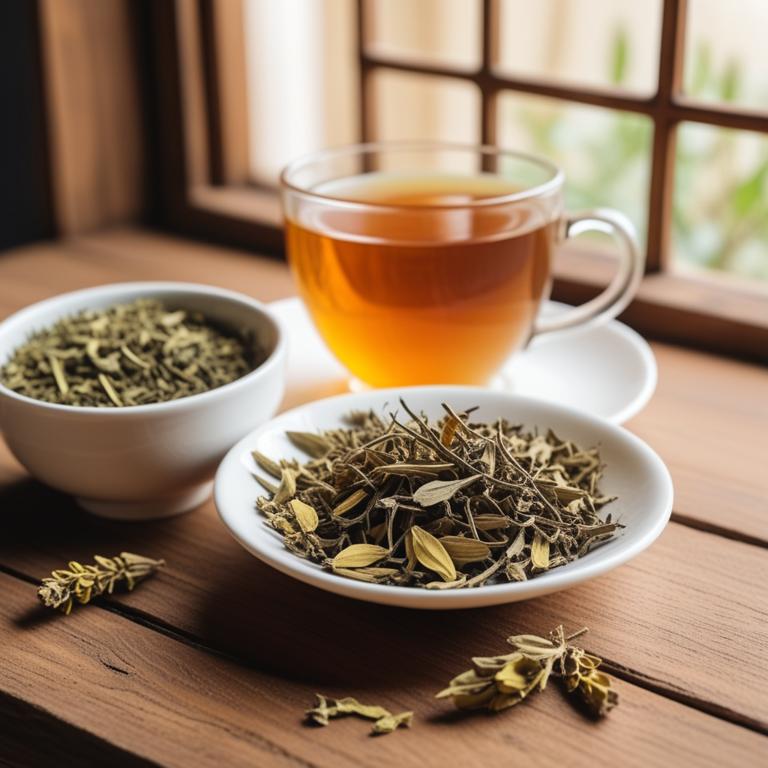
Herbal teas have been around for centuries, and they're gaining popularity as a natural remedy for high cholesterol.
So, what makes them effective?. Well, many of these herbs have properties that help to reduce inflammation in the blood vessels and improve circulation. This, in turn, helps to lower cholesterol levels and prevent the buildup of plaque in the arteries. Take Ginkgo biloba, for instance. This ancient herb has been used to improve blood flow and reduce the risk of heart disease. Its active compounds, flavonoids and terpenoids, have antioxidant properties that help to protect the body from free radicals and oxidative stress. This means that Ginkgo biloba can help to keep your blood vessels healthy and your cholesterol levels in check. Another example is Panax ginseng, also known as Asian ginseng.
This herb is known for its ability to improve circulation and reduce inflammation. It's believed to have a positive effect on the body's natural cholesterol-regulating mechanisms, which helps to keep cholesterol levels within a healthy range. Lastly, there's Zingiber officinale, or ginger. This spicy root has anti-inflammatory properties that can help to reduce the risk of heart disease. Its active compounds, gingerols and shogaols, have been shown to have a positive effect on cholesterol levels by reducing the levels of LDL (bad) cholesterol and increasing the levels of HDL (good) cholesterol. Drinking herbal teas like these can have a significant impact on your life. By reducing inflammation and improving circulation, they can help to lower your cholesterol levels and reduce your risk of heart disease. This means that you'll be less likely to experience symptoms like high blood pressure, shortness of breath, and fatigue.
Plus, by incorporating these teas into your daily routine, you'll be taking a proactive approach to your health and well-being.
- 1. Ginkgo biloba
- 2. Panax ginseng
- 3. Zingiber officinale
- 4. Rosmarinus officinalis
- 5. Silybum marianum
- 6. Curcuma longa
- 7. Trifolium pratense
- 8. Glycyrrhiza glabra
- 9. Cinnamomum verum
- 10. Cassia auriculata
1. Ginkgo biloba

Ginkgo biloba teas contains flavonoids and bilobalide as its bioactive constituents.
These compounds have antioxidant and anti-inflammatory properties that help to lower cholesterol levels by reducing the production of LDL (bad) cholesterol. Flavonoids, specifically quercetin and kaempferol, improve blood vessel function and increase the flexibility of blood vessels, allowing blood to flow more easily and reducing the risk of blood clots. Bilobalide has a protective effect on the liver, which is responsible for removing excess cholesterol from the blood.
By improving liver function and increasing the flow of blood, Ginkgo biloba teas helps to reduce the amount of LDL cholesterol in the blood.
- Gather 1 cup of boiling water and 1 teaspoon of dried Ginkgo biloba leaves.
- Steep the Ginkgo biloba leaves in the boiling water for 5-7 minutes.
- Strain the liquid using a fine-mesh sieve or cheesecloth into a cup.
- Add 1 tablespoon of honey (optional) to the liquid and stir well.
- Drink the Ginkgo biloba tea 1-2 times a day, ideally before meals, to help manage high cholesterol.
2. Panax ginseng
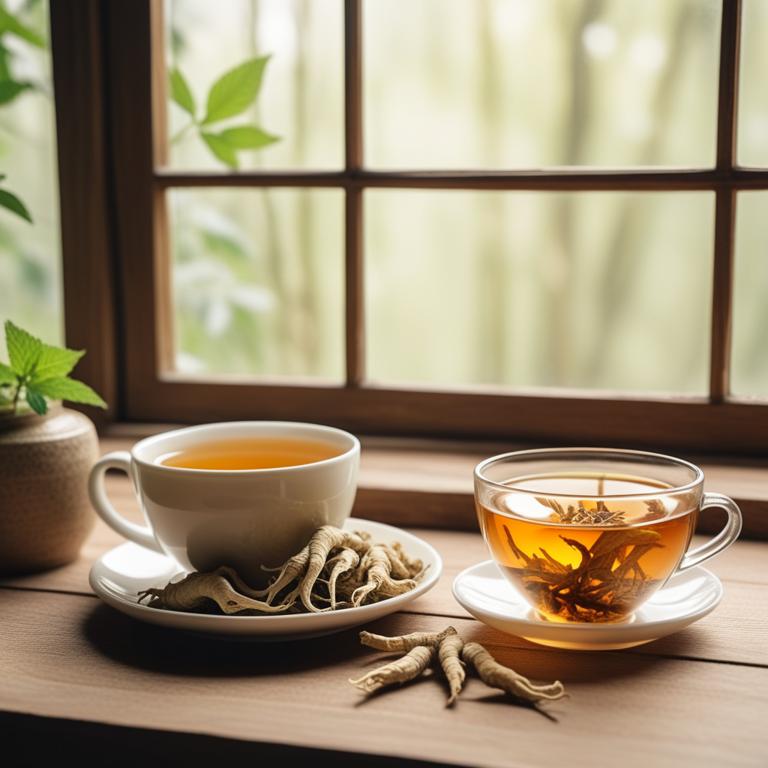
Panax ginseng teas contains active constituents like ginsenosides, which are responsible for its health benefits.
These ginsenosides have a cholesterol-lowering effect due to their ability to inhibit the production of cholesterol in the liver. Ginsenosides also help to improve blood lipid profiles by increasing high-density lipoprotein (HDL) cholesterol levels and reducing low-density lipoprotein (LDL) cholesterol levels. Furthermore, Panax ginseng teas contain saponins, which help to reduce the absorption of dietary cholesterol in the gut.
By inhibiting cholesterol production and reducing cholesterol absorption, Panax ginseng teas may help to lower high cholesterol levels.
- Gather 1 cup of water, 1 teaspoon of dried Panax ginseng, and a tea infuser or strainer.
- Boil the water in a pot and let it cool for 1 minute.
- Place the dried Panax ginseng in the tea infuser or strainer and put it into the pot.
- Steep the ginseng for 5-7 minutes, then remove the infuser or strainer.
- Drink the tea 2-3 times a day, after meals, to help manage high cholesterol.
3. Zingiber officinale

Zingiber officinale teas contains gingerols and shogaols, two active constituents that have been shown to help lower cholesterol levels.
These compounds work by inhibiting the production of cholesterol in the liver and improving the body's ability to break down and remove excess cholesterol. Gingerols and shogaols also have anti-inflammatory properties, which can help reduce inflammation in the blood vessels and prevent the buildup of plaque that can lead to high cholesterol. Additionally, Zingiber officinale teas has been found to increase the levels of high-density lipoprotein (HDL) or "good" cholesterol, which helps remove excess cholesterol from the bloodstream.
By reducing cholesterol production, improving cholesterol breakdown, and increasing HDL levels, Zingiber officinale teas may be beneficial for individuals with high cholesterol.
- Gather 1 cup of water and 1 tablespoon of dried Zingiber officinale root.
- Boil the water and let it cool for 1 minute.
- Add 1 tablespoon of dried Zingiber officinale root to the cooled water.
- Steep the mixture for 5-7 minutes, then strain it.
- Drink 1 cup of the tea, 2-3 times a day, for a week to see its effects on high cholesterol.
Zingiber Officinale Tea on Amazon
FGO Organic Ginger Tea, 100 Count, Eco-Conscious Tea Bags, Caffeine Free, Packaging May Vary (Pack of 1)
Disclaimer: We earn a commission if you click this link and make a purchase at no additional cost to you.
4. Rosmarinus officinalis

Rosmarinus officinalis teas contains rosmarinic acid, a compound that has been shown to help lower cholesterol levels.
This is due to its ability to increase the breakdown of triglycerides in the body, which are a type of fat that contributes to high cholesterol. Rosmarinic acid also has antioxidant properties, which help to protect the body's cells from damage caused by free radicals that can lead to high cholesterol. The tea's high concentration of carnosic acid and carnosol, which are also found in rosemary, further support its cholesterol-lowering properties.
By increasing the body's ability to break down and remove excess fat, Rosmarinus officinalis teas can help to reduce high cholesterol levels.
- Gather 1 cup of fresh Rosmarinus officinalis (Rosemary) leaves.
- Combine 1 cup of fresh Rosemary leaves with 1 cup of boiling water in a heat-resistant cup.
- Steep the mixture for 5-7 minutes, then strain the liquid using a fine-mesh sieve or cheesecloth.
- Combine 1 cup of the strained Rosemary tea with 1 cup of cold water and stir in 1 tablespoon of honey (optional).
- Drink 1 cup of the Rosemary tea, 2-3 times a day, to help lower high cholesterol levels.
5. Silybum marianum
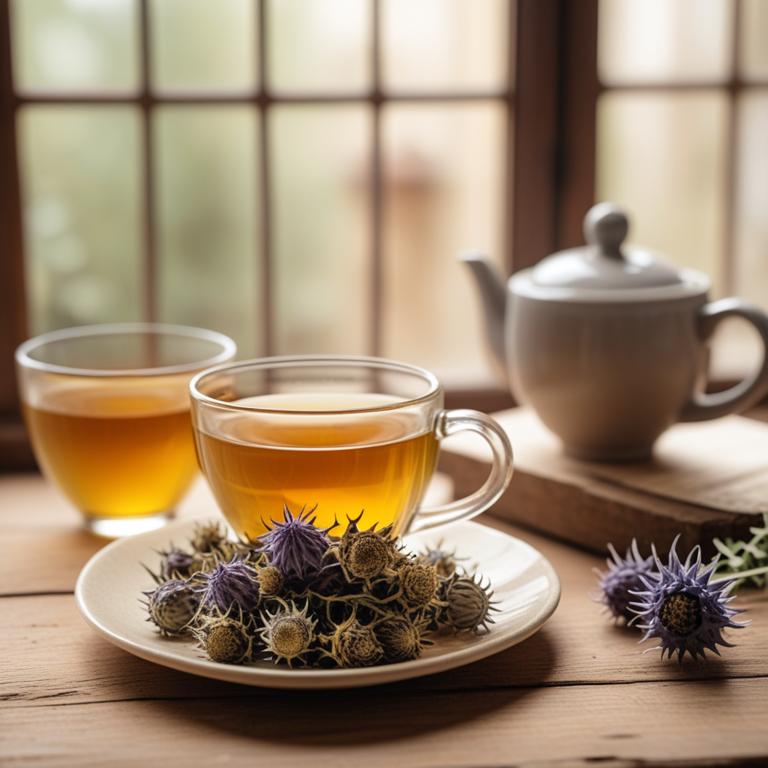
Silybum marianum teas contains silymarin, a mixture of flavonoids and polyphenols, including silibinin, silidianin, and silicristin.
These compounds have antioxidant and anti-inflammatory properties that help protect the liver and improve blood lipid profiles. Silymarin also enhances the activity of lipoprotein lipase, an enzyme that breaks down triglycerides in the blood, which contributes to lower cholesterol levels. Additionally, silymarin has been shown to decrease the production of LDL cholesterol and increase the production of HDL cholesterol, further improving blood lipid profiles.
By regulating lipid metabolism and reducing oxidative stress, Silybum marianum teas may be beneficial for individuals with high cholesterol.
- Gather Silybum marianum flowers and leaves. Use 1 cup of fresh or dried flowers and leaves.
- Heat 2 cups of water in a pot. Bring the water to a boil.
- Add 1 cup of Silybum marianum flowers and leaves to the boiling water. Reduce heat to low.
- Steep the mixture for 5-7 minutes. Strain the liquid using a tea strainer or cheesecloth.
- Drink 1 cup of Silybum marianum tea 2-3 times a day. Consult a doctor before using as a treatment for high cholesterol.
6. Curcuma longa
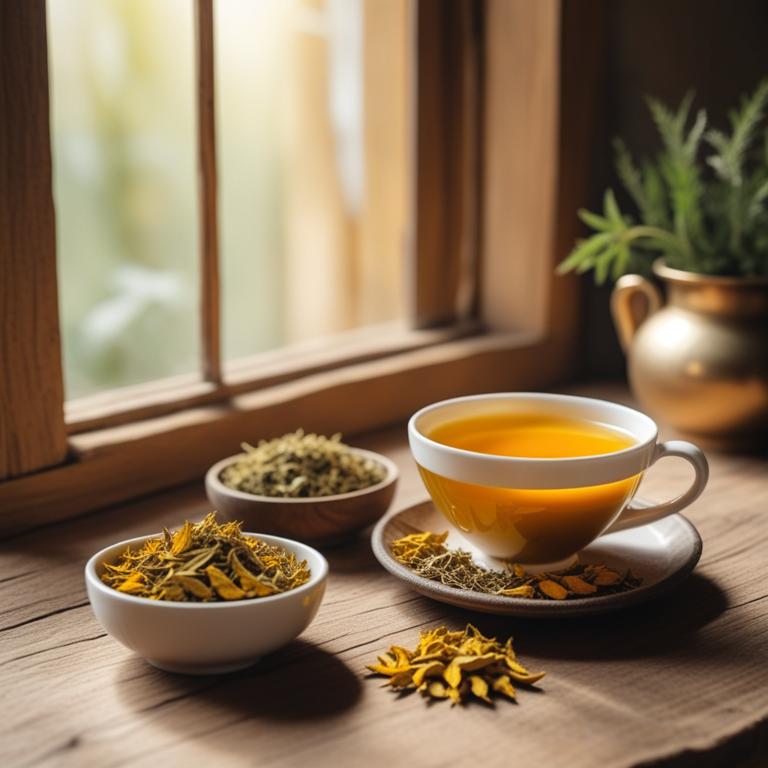
Curcuma longa teas contains a compound called curcumin, which is responsible for its health benefits.
Curcumin is rich in antioxidants and has anti-inflammatory properties, which can help reduce the production of bad cholesterol in the liver. It also contains a compound called turmericin, which has been shown to inhibit the formation of plaque in arteries, a major contributor to high cholesterol. The bioactive constituents in Curcuma longa teas, including curcumin and demethoxycurcumin, have been found to improve lipid profiles by increasing the levels of good cholesterol and reducing triglycerides.
By reducing inflammation and improving lipid profiles, Curcuma longa teas may help lower high cholesterol levels and reduce the risk of heart disease.
- Gather 1 teaspoon of dried Turmeric root (Curcuma longa) and 1 cup of boiling water.
- Add the Turmeric root to the boiling water and stir for 1 minute.
- Reduce heat to low and let it simmer for 5-7 minutes.
- Strain the mixture into a cup using a fine-mesh sieve or cheesecloth.
- Drink the tea 1-2 times a day, ideally after meals, to help lower cholesterol levels.
7. Trifolium pratense
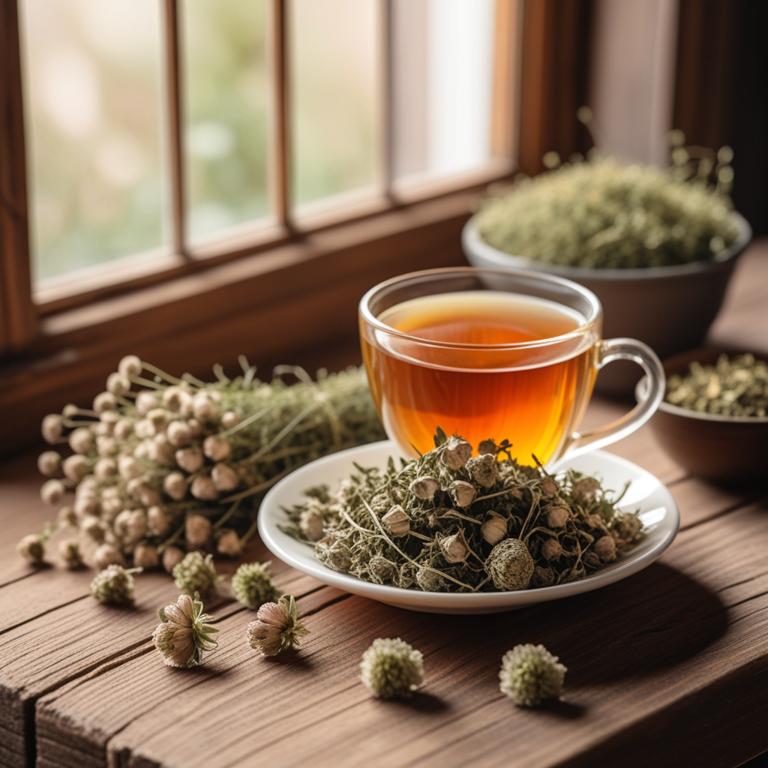
Trifolium pratense teas contains isoflavones, particularly genistein and biochanin A, which are known to have cholesterol-lowering properties.
These isoflavones help to reduce the production of low-density lipoprotein (LDL) cholesterol, also known as "bad" cholesterol, by inhibiting the enzyme HMG-CoA reductase. Additionally, trifolium pratense teas contain saponins, which have been shown to reduce the absorption of dietary cholesterol in the gut. The isoflavones in trifolium pratense teas also have been found to improve lipid profiles by increasing high-density lipoprotein (HDL) cholesterol, or "good" cholesterol, and reducing triglycerides.
Regular consumption of trifolium pratense teas may help to reduce the risk of heart disease associated with high cholesterol levels.
- Gather 1 cup of dried Trifolium pratense (Red Clover) flowers.
- Combine the dried flowers with 1 cup of boiling water in a saucepan.
- Let the mixture steep for 5-7 minutes, then strain it using a tea strainer.
- Add 1 tablespoon of honey to the tea, if desired, and stir well.
- Drink 1-2 cups of the tea per day, as needed, to support heart health and lower cholesterol.
8. Glycyrrhiza glabra

Glycyrrhiza glabra teas contains glycyrrhizin, a triterpenoid saponin that has been shown to help lower high cholesterol levels.
Glycyrrhizin works by inhibiting the production of corticosteroids, which can contribute to high cholesterol. The tea also contains flavonoids, such as isorhapontigenin and liquiritigenin, which have antioxidant properties that help protect against cholesterol oxidation. These antioxidants reduce the formation of plaque in the arteries, making it easier for blood to flow and lowering blood pressure.
The combination of glycyrrhizin and flavonoids in Glycyrrhiza glabra teas helps to improve lipid profiles and reduce the risk of cardiovascular disease.
- Gather 1 teaspoon of dried Glycyrrhiza glabra root and 1 cup of boiling water.
- Steep the root in the boiling water for 5-7 minutes.
- Strain the mixture into a cup and discard the root.
- Add 1 tablespoon of honey to the tea, if desired.
- Drink the tea 2-3 times a day, after meals, for best results.
9. Cinnamomum verum
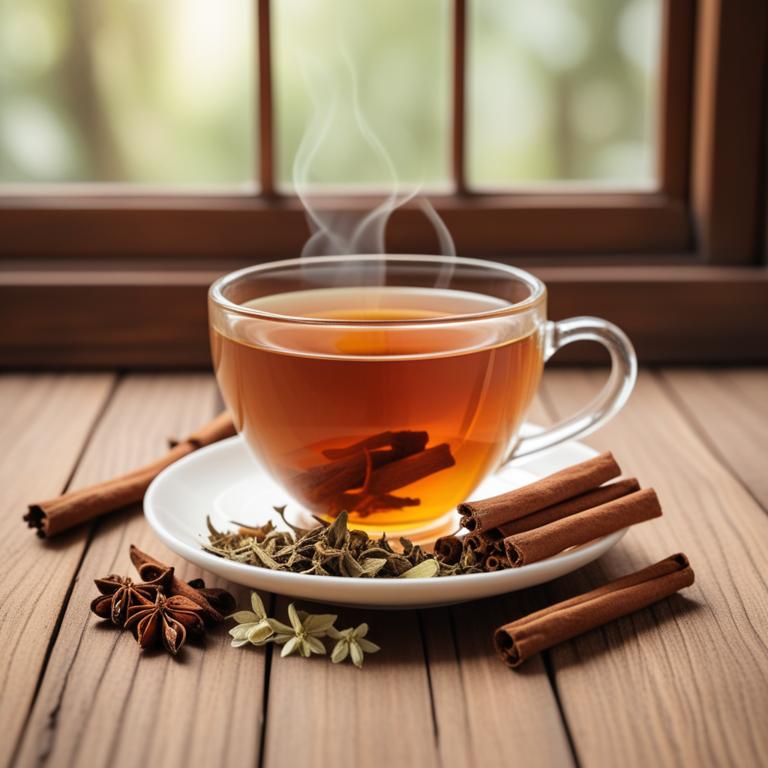
Cinnamomum verum teas contains active constituents like cinnamaldehyde and cinnamic acid.
These compounds have anti-inflammatory properties that help reduce inflammation in the blood vessels, which can contribute to high cholesterol. Cinnamaldehyde also has antioxidant properties that neutralize free radicals, which can damage the cells lining the blood vessels and increase cholesterol levels. The coumarin present in Cinnamomum verum tea has been shown to inhibit the absorption of dietary cholesterol in the gut, reducing its entry into the bloodstream.
Regular consumption of Cinnamomum verum tea may lead to improved lipid profiles and reduced levels of low-density lipoprotein (LDL) cholesterol.
- Gather 1 teaspoon of Cinnamomum verum powder and 1 cup of boiling water.
- Add the Cinnamomum verum powder to the boiling water and stir well.
- Let the mixture steep for 5-7 minutes to allow the flavors to meld.
- Strain the tea into a cup and discard the solids.
- Drink 1 cup of the Cinnamomum verum tea 2-3 times a day to help manage high cholesterol.
10. Cassia auriculata

Cassia auriculata teas contains bioactive constituents like flavonoids, alkaloids, and terpenoids.
These compounds help to lower cholesterol levels by reducing the absorption of dietary cholesterol in the gut. The flavonoids in Cassia auriculata teas also have antioxidant properties, which can help to prevent the oxidation of LDL (bad) cholesterol, a process that contributes to the development of atherosclerosis. The alkaloids present in the tea, such as auriculasin and cassiadin, have been shown to inhibit the activity of HMG-CoA reductase, an enzyme involved in cholesterol synthesis.
By reducing both dietary cholesterol absorption and cholesterol synthesis, Cassia auriculata teas may be a useful adjunct in managing high cholesterol levels.
- Gather 2 tablespoons of dried Cassia auriculata leaves and 1 cup of boiling water.
- Steep the leaves in the boiling water for 5-7 minutes.
- Strain the mixture into a cup and discard the leaves.
- Add 1 tablespoon of honey to the tea, if desired, and mix well.
- Drink the tea 2-3 times a day, preferably after meals, to help manage high cholesterol.